Are you thinking about setting up a website for your construction company? You’re already a step in the right direction. Having a website for your construction business will help potential clients find your company faster and more efficiently.
For your business website to deliver the desired results, its design and development must be strategically thought out with intent and purpose. A website is not just an address on the Internet with pages that show the client who you are and what you do.
An effective website is one that answers the question: “Why are we the best construction company for your project?”
4 Reasons Why Your Construction Company Needs A Website
If you’re still on the fence about getting a website for your construction company, here are 4 reasons you should give us a call so we can set one up for you right away:
1. Market and Promote Your Construction Business
Building property, whether a residential home or a commercial establishment, will entail a huge investment. Your clients are prepared to shell out thousands or millions of dollars to develop their property.
What will it tell them if the construction company isn’t even willing to invest in a website for its business?
Your competitors have websites. If you don’t have one for your business, it definitely will put you in the back of the line as far as the potential client is concerned.
Think of your website as an Internet-based company brochure. There’s no need to bring hard copies wherever you go. A prospect can simply click on your URL and learn everything about you and your business from the website.
A construction company website that looks amazing, mobile responsive, highly informative, and extremely functional will greatly impress prospective clients.
2. Grow Your Business
But a website is more than just a company brochure. It can be equipped with different functions and features that will help your business grow.
For example, a website can have forms for newsletter signups and contact listings that will collect information about your visitor. The collected information becomes leads that can be used for email marketing campaigns.
Web Pages can be fitted with social sharing icons to enable site visitors to share your content with their community.
An e-portal can be added so you can sell products and services from the website and create another stream of revenue.
As a construction company, your e-portal can sell products such as power tools, safety equipment, and flooring materials. You might also want to include services for pest control and disinfection.
These products and services will enhance the value proposition of your construction business and diversify it into other markets.
3. Highlight Your Accomplishments
The answer to “Why” can be found in your portfolio. Potential clients want to see what you’ve done in the industry.
Having a web page that functions as a gallery of the projects you’ve done will certainly help the client make an educated decision of which company to hire. Likewise, include the awards and citations that you’ve received in the industry.
4. Improve Customer Service
You might have site visitors who are one click away from hiring your services but have nagging questions that need to be answered.
Integrating a live chat agent on the website will give the final push to convert interest into a new client for your construction company.
You can also include email support services on your website by adding fill-out forms. Not only will these forms resolve the customer’s concerns faster but they will give you key information that will help you develop a better understanding of who your customers are.

5 Best Website Design Elements For Your Construction Company
When it comes to website design, beauty is in the eyes of the beholder. And the beholder is your audience.
For a construction company, you need a website design that best represents your approach to construction and at the same time accurately captures what you’ve done in the industry, how you’ve performed, and who the company is.
Because of the amount of investment involved, chances are the potential client will be talking to multiple construction companies. Therefore, the objective of the design is to at least get the site visitor interested and consider you for the project.
Here are 5 of the most important web design elements that your construction company website must possess.
1. User-friendly Design
Clients may have different needs and requirements in mind but one thing they share in common is that they don’t want to spend time accessing and figuring out your website.
Designing a website that’s friendly and easy to use for your potential clients should be a top priority.
What are the qualities of a user-friendly website?
- Mobile-responsive – Your construction business website must set up and function properly on mobile devices regardless of screen size.
- Fast-loading time – If your website takes longer than 3 seconds to load, your potential clients might click out and visit your competitors’ websites.
- Highly navigable – Site visitors can easily find their way around your website. The menu, social media icons, CTA and signup buttons, and contact forms are properly located and immediately visible.
A business website that’s not user-friendly might create the impression you’re difficult to deal with or that you’re not concerned with the needs of the client.
2. Content Built and Optimized for Mobile Devices
According to a study by Statista, 54.8% of Internet traffic originates from mobile devices.
People who are looking for a construction company to handle their projects could be searching for a business such as yours from their smartphones, laptops, or tablets.
Content that’s built and optimized for mobile devices means they’re easy to read and access:
- No zooming-in or out just to read your content.
- The paragraphs and sentences are short to make them more scrollable.
- The images are relevant, high-resolution, and do not slow down the page loading time.
- The menu is easily found and the drop-down content is well-organized.
Having a website that’s optimized for mobile is a sign that you’re a business that cares for your customers.
3. Customer-centered
Yes – the website is about your business and what you can do for your customers. But that doesn’t mean it should only be about you.
Customers already know that you’re a company that’s in the business of doing construction, just like the other websites they’ve visited.
What a customer is looking for is a company that can provide the solution to his/her problem. This is different from hiring a company that meets his/her construction requirements. That matter will be discussed in #5.
The customer has probably visited multiple websites that have the same qualifications as your company. The question you have to answer is why the customer should choose you over others assuming all qualifications are equal or similar.
This is why it’s important to have a customer-centric website.
Designing a customer-centric construction business website starts at the homepage. It must feature a unique, relevant, and compelling value proposition that best captures the message of your brand and the needs of your customer.
When a customer clicks on your URL, he/she will land on your homepage. The first group of text that he/she will come across is your BVP – Brand Value Proposition.
The BVP has fewer than 6 seconds to capture the interest of the customer. It must be strong, concise, and leaves no time for second-guessing.
The next important page is the About Us page.
A 2015 study by Huff Industrial Marketing, KOMarketing, and Buyer Zone revealed that 52% of website visitors checked out its About Us page after landing on the homepage.
Instead of writing about what your key people accomplished in college and the industry, share stories on why they got into construction.
Here are a few good examples of storytelling:
- You got into the business of construction because you wanted to build homes that accurately reflected the personality of the owner and the needs of his/her family.
- The company introduced a flexible payment system because you understand as a homeowner, the massive investment required to put up a home.
- You ventured into commercial property development because you wanted the opportunity to introduce designs that rectified the flaws of the current commercial properties.
Customers understand that this is a profit-making business. What they want to know is who has their best interests at heart so they can comfortably and confidently entrust their hard-earned money to build their property.
4. Strong Call-to-Action
What do you want the website visitor to do next? That’s the objective of your Call-to-Action (CTA).
Time is a crucial factor for a business website to be successful. You can’t allow the site visitor to think of any other option except to pursue his/her interest in your website.
Once someone lands on your website, you have to direct that person to do what you want.
Do you want the site visitor to:
- Book a virtual appointment?
- Take a virtual tour of your website?
- Fill out a contact form?
- Sign up for a monthly newsletter?
- Share your content on social media?
Your website can have multiple CTAs. The most important thing to remember when creating a CTA is to be concise and direct:
- Book an Appointment NOW.
- Click and Take a Virtual Tour of our Projects.
- Fill Out a Form Now – Hear From Us in 24 Hours.
- Stay Updated – Sign Up for our Monthly Newsletter.
- Share With Your Community.
For your CTA to be effective, it has to be strong and definitive.
5. Creates a Sales Conversion Funnel
A good way to look at your website is to view it as a sales conversion funnel.
And this is why you need Digital Marketing.
Digital marketing works to drive traffic to your website by using different strategies, processes, tools, tactics, and channels. The greater the traffic that flows into your website, the larger and wider the opening of your sales funnel.
When your digital marketing efforts have done their job, it’s time for your website to go to work by converting interest into income. You can do this by designing a website with features that create a sales conversion funnel:
The Homepage
As discussed earlier, the homepage is where visitors first land when they click on your URL. The motivation to click on your URL stems from a need to find answers to their questions.
The answers have to be provided by your BVP. If the BVP answers the questions to the visitor’s satisfaction, there’s a good chance that he/she will explore your website further by scrolling down the homepage.
What types of content can be included in the homepage to heighten the interest of the visitor?
- Company’s Qualifications – Licenses, Certifications (LEED, ISO-4001, ISO-14001).
- Industry Awards and Recognitions.
- Ratings (Better Business Bureau)
- State and Industry Organization Memberships and Affiliations.
- Testimonials from Clients
- Service Reviews
- List of Clients
The homepage is a key section of your website. It has to impress the site visitor, not just with its design but also its contents.
About Us
We discussed the importance of the About Us page in #3, so we won’t delve into the topic much further.
However, we’d be remiss if we didn’t discuss the key points in coming up with an effective About Us page:
- Include a brief history of your company.
- Share your Mission and Vision.
- Feature only the key decision-makers of your company but include an image of your team or personnel.
- Use only high-resolution images.
- Include a link to press mentions; if any.
It might also help to be less formal when it comes to writing.
We’ve come across good About Us page designs where the key decision-makers share information to their readers about their hobbies and interests. The purpose is to make top management more accessible to potential customers.
The Portfolio Page
Proof of your experience and expertise can be found on the Portfolio Page of your website. This webpage functions as the showcase gallery of the projects your company has completed.
The important details to keep in mind are as follows:
- Use high-resolution images only and if possible, give a 360-degree virtual tour of some locations.
- State the name of the client and the address of the project. Make sure you get the approval of the client before posting these types of information.
- Mention the floor area, lot area, and the inclusive period of completion.
Don’t mention the cost of the project. If the site visitor is interested, he/she can ask these confidential questions during your meeting.
Contact Us Page
If the site visitor becomes interested, he/she will head over to your Contact Us page.
Your Contact Page must have the following information and features available:
- Contact email address.
- Name of contact person(s).
- Office number – landline and mobile.
- Business address.
- Location map.
- Client information fill-out form.
- Fill-out form for questions.
- Chat support box.
Lastly, always keep the information on the Contact Us page updated.
VERY IMPORTANT: Provide Value in Return for Opt-ins for Email Addresses
Despite all of these features and pages, a site visitor might not pursue – for now. He/she might need some time to review all of the websites visited, evaluate the findings, and get third-party opinions before making a decision to move forward.
In the meantime, your website’s opt-in features can contribute to the sales conversion cause by providing value in return for the visitor’s email address.
Here are a few ideas you can consider to entice your visitors to actively participate in your site’s opt-in features:
- Free 30-minute consultation.
- Free estimate.
- Discount on construction materials.
- Special invitations to projects that are pre-selling.
- Informative e-books and materials about construction, interior design, landscaping, and other related topics.
Getting your website visitors is one thing. Convincing them that they’ve come to the right place is another. When it comes to your website, it’s all about User Experience.
Conclusion
Designing a website for your construction company is pretty much like designing a house for your client.
You want to design a house that provides for the needs of the client as well as one that best represents who he/she is. When visitors step inside your client’s home, they will say “This house is so you!”
The same can be said for your construction business website. It must be designed to provide for the needs and requirements of your clients and at the same time give the visitor a good idea of who you are; the people behind the company.
So if you’ve decided to put up a website – give us a call or drop an email. You’re the experts in construction, we’re the experts in designing websites!
And if you enjoyed this article, feel free to share it with your community.






